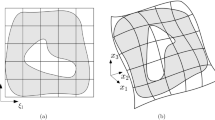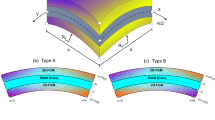Abstract
An efficient and meshfree approach is proposed for the bending analysis of thin plates. The approach is based on the choice of a set of interior points, for each of which a basis function can be defined. Plate deflection is then approximated as the linear combination of those basis functions. Unlike traditional meshless methods, present basis functions are defined in the whole domain and satisfy the governing differential equation for plate. Therefore, no domain integration is needed, while the unknown coefficients of deflection expression could be determined through boundary conditions by using a collocation point method. Both efficiency and accuracy of the approach are shown through numerical results of plates with arbitrary shapes and boundary conditions under various loads.
Similar content being viewed by others
References
Ugural A C. Plates and Shells: Theory and Analysis. 4th ed. Boca Raton: CRC Press, 2018
Oñate E. Structural Analysis with the Finite Element Method. Linear Statics: vol. 2: Beams, Plates and Shells. Barcelona: International Center for Numerical Methods in Engineering (CIMNE), 2013
Katsikadelis J T. The Boundary Element Method for Plate Analysis. London: Elsevier, 2014
Karttunen A T, von Hertzen R, Reddy J N, Romanoff J. Exact elasticity-based finite element for circular plates. Computers & Structures, 2017, 182: 219–226
Nguyen-Xuan H. A polygonal finite element method for plate analysis. Computers & Structures, 2017, 188: 45–62
Karttunen A T, von Hertzen R, Reddy J N, Romanoff J. Shear deformable plate elements based on exact elasticity solution. Computers & Structures, 2018, 200: 21–31
Katili I, Batoz J L, Maknun I J, Lardeur P. A comparative formulation of DKMQ, DSQ and MITC4 quadrilateral plate elements with new numerical results based on s-norm tests. Computers & Structures, 2018, 204: 48–64
Videla J, Natarajan S, Bordas S P A. A new locking-free polygonal plate element for thin and thick plates based on Reissner-Mindlin plate theory and assumed shear strain fields. Computers & Structures, 2019, 220: 32–42
Mishra B P, Barik M. NURBS-augmented finite element method for static analysis of arbitrary plates. Computers & Structures, 2020, 232: 105869
Nhan N M, Nha T V, Thang B X, Trung N T. Static analysis of corrugated panels using homogenization models and a cell-based smoothed mindlin plate element (CS-MIN3). Frontiers of Structural and Civil Engineering, 2019, 13(2): 251–272
Liu G R. Meshfree Methods: Moving Beyond the Finite Element Method. 2nd ed. Boca Raton: CRC Press, 2010
Leitão V M A. A meshless method for Kirchhoff plate bending problems. International Journal for Numerical Methods in Engineering, 2001, 52(10): 1107–1130
Liu Y, Hon Y C, Liew L M. A meshfree Hermite-type radial point interpolation method for Kirchhoff plate problems. International Journal for Numerical Methods in Engineering, 2006, 66(7): 1153–1178
Chen J S, Hillman M, Chi S W. Meshfree methods: Progress made after 20 years. Journal of Engineering Mechanics, 2017, 143(4): 04017001
Zhang H J, Wu J Z, Wang D D. Free vibration analysis of cracked thin plates by quasi-convex coupled isogeometric-meshfree method. Frontiers of Structural and Civil Engineering, 2015, 9(4): 405–419
Pirrotta A, Bucher C. Innovative straight formulation for plate in bending. Computers & Structures, 2017, 180: 117–124
Battaglia G, Di Matteo A, Micale G, Pirrotta A. Arbitrarily shaped plates analysis via Line Element-Less Method (LEM). Thin-walled Structures, 2018, 133: 235–248
Nguyen V P, Anitescu C, Bordas S P A, Rabczuk T. Isogeometric analysis: An overview and computer implementation aspects. Mathematics and Computers in Simulation, 2015, 117: 89–116
Zheng H, Liu Z J, Ge X R. Numerical manifold space of hermitian form and application to Kirchhoff’s thin plate problems. International Journal for Numerical Methods in Engineering, 2013, 95(9): 721–739
Guo H W, Zheng H, Zhuang X Y. Numerical manifold method for vibration analysis of Kirchhoff’s plates of arbitrary geometry. Applied Mathematical Modelling, 2019, 66: 695–727
Guo H W, Zhuang X Y, Rabczuk T. A deep collocation method for the bending analysis of Kirchhoff plate. CMC-Computers Materials & Continua, 2019, 59(2): 433–456
Zhuang X Y, Guo H W, Alajlan N, Zhu H H, Rabczuk T. Deep autoencoder based energy method for the bending, vibration, and buckling analysis of Kirchhoff plates with transfer learning. European Journal of Mechanics-A/Solids, 2021, 87: 104225
Guo H W, Zhuang X Y. The application of deep collocation method and deep energy method with a two-step optimizer in the bending analysis of Kirchhoff thin plate. Chinese Journal of Solid Mechanics, 2021, 42(3): 249–266 (in Chinese)
Li S C, Dong Z Z, Zhao H M. Natural Boundary Element Method for Elastic Thin Plates in Bending and Plane Problems. Beijing: Science Press, 2011 (in Chinese)
Acknowledgements
Financial support from the Natural Science Foundation of Guangdong Province (No. 2020A1515011196) is gratefully acknowledged.
Author information
Authors and Affiliations
Corresponding authors
Rights and permissions
About this article
Cite this article
Du, W., Zhao, X., Hou, H. et al. A new meshless approach for bending analysis of thin plates with arbitrary shapes and boundary conditions. Front. Struct. Civ. Eng. 16, 75–85 (2022). https://doi.org/10.1007/s11709-021-0798-5
Received:
Accepted:
Published:
Issue Date:
DOI: https://doi.org/10.1007/s11709-021-0798-5




